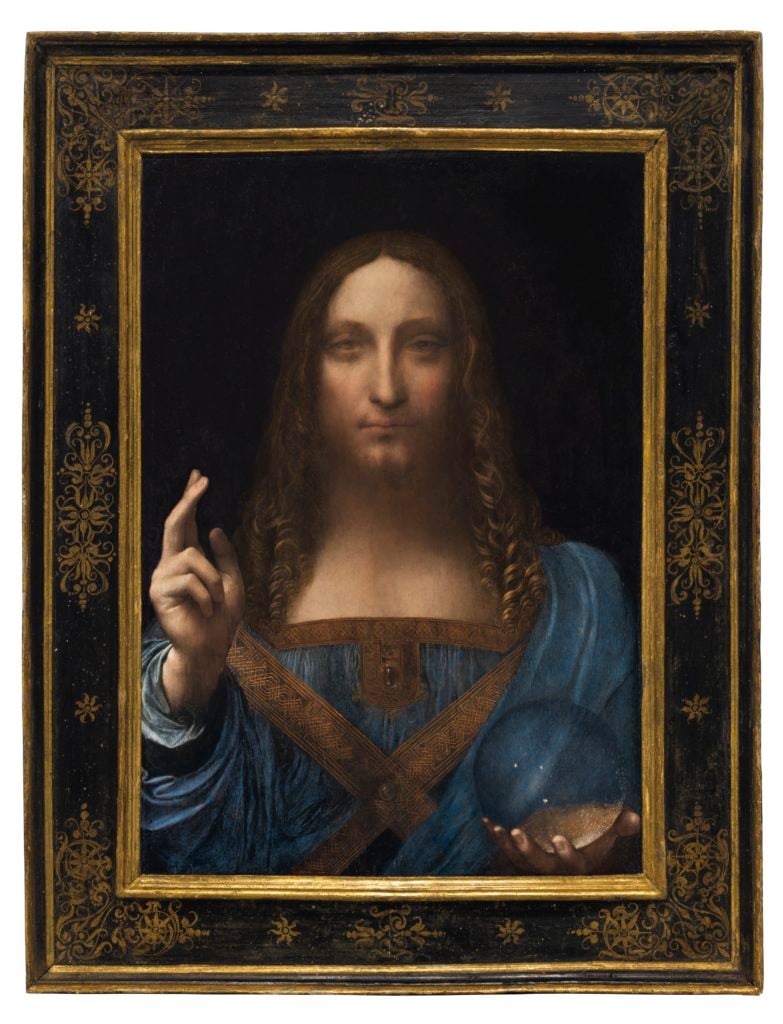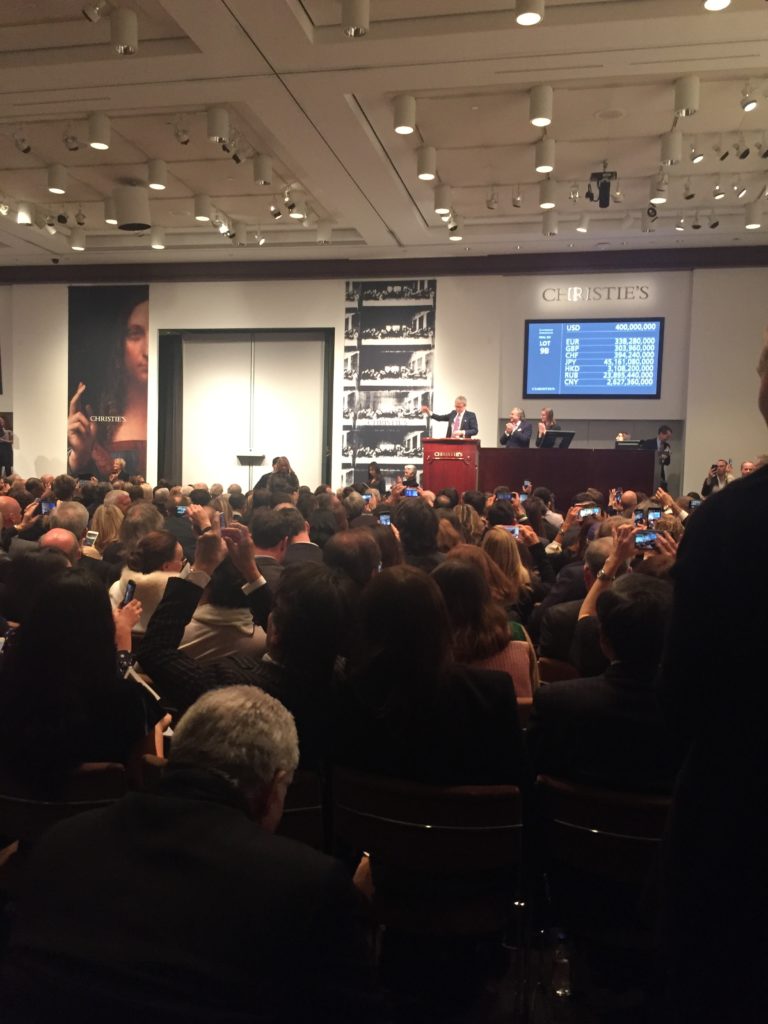Auctions
‘Salvator Mundi,’ the Last Known Painting by Leonardo da Vinci Just Sold for $450.3 Million
The 500-year-old painting is, by far, the most expensive work ever sold at auction.

The 500-year-old painting is, by far, the most expensive work ever sold at auction.

Eileen Kinsella

After weeks of anticipation, it finally happened: Leonardo da Vinci’s Salvator Mundi (circa 1500), billed as the last known painting by the Renaissance master in private hands, sold at Christie’s for $450.3 million. It is, by far, the most expensive work of art ever sold at auction. In fact, the price is more than double the next most expensive work ever sold, Picasso’s Les femmes d’Alger (Version ‘O’), which fetched $179.4 million in 2015.
The work went to an anonymous client of Alex Rotter, Christie’s global co-head of contemporary art. Before a packed salesroom and scores of camera phones held aloft, bidding opened at $70 million. At $190 million, five bidders—four on the phones and one in the room—were still chasing the painting.
The 19-minute contest eventually came down to Rotter and Francois De Poortere, the head of Christie’s Old Master painting department in New York.
At $352 million, auctioneer Jussi Pylkkanen produced a glass of ice water from behind the rostrum and took a sip.
After a protracted bidding war in which Rotter’s client continued to bid in increments as large as $30 million—and De Poortere’s client bid in smaller steps of around $2 million–5 million—the work hammered down for $400 million to a flurry of applause (and a few gasps). With the auction house’s fees, the final price was $450.3 million.
The painting was one of 58 works included in Christie’s evening sale of postwar and contemporary art on Wednesday at Rockefeller Center in New York.

Christie’s salesroom the moment after the hammer came down, selling Leonardo’s Salvator Mundi for $400 million. Photo: Eileen Kinsella.
Salvator Mundi was consigned by the Russian billionaire Dmitry Rybolovlev, who bought it in 2013. At tonight’s sale, the work carried a guarantee by a third party, which means that an outside buyer had essentially committed to purchase the painting in advance for $100 million. (In exchange for the early commitment, the guarantor will receive a share of the profits above $100 million.)
The auction house took the unusual move of placing the work in its evening contemporary art auction, essentially betting that it would appeal to the biggest trophy-hunting art collectors regardless of when it was made. And indeed, the battle eventually came down to an Old Master specialist (De Poortere) and a contemporary one (Rotter), with the latter emerging victorious after a long sequence of aggressive bids.
Until now, the most expensive painting ever sold at auction was Pablo Picasso’s Les femmes d’Alger (Version ‘O’) (1955), which was sold at another genre-mixing sale at Christie’s in May 2015 for $179.4 million. (Accounting for inflation, the price is around $186 million in 2017 dollars.)
And though it was included in the contemporary sale, Salvator Mundi also easily become the most expensive Old Master painting ever sold at auction. It broke the record set by Peter Paul Rubens’s Massacre of the Innocents (1612), which fetched $76.7 million (equivalent to $106 million today) at Sotheby’s in 2002.
The Leonardo painting has a dramatic backstory that involves a royal family, an estate sale, and a contentious lawsuit. Originally commissioned for the French Royal collection, it went missing for decades. In 2005, a consortium of dealers spotted the painting at an estate sale and had it authenticated as a bona fide Leonardo. In 2013, they sold the work to Swiss dealer and so-called “freeport king” Yves Bouvier for a price reportedly between $75 million and $80 million.
Bouvier then flipped the work to Russian billionaire Dmitry Rybolovlev for a reported $127.5 million. The colossal mark-up eventually touched off a contentious legal battle between the two men that is still playing out in international courts.
Although Rybolovlev made a tidy profit on his purchase, the record-breaking sale has done little to repair the relationship between the billionaire and his former advisor. “Thanks to the professionalism and expertise of Christie’s, the record-breaking sale of Da Vinci’s Salvator Mundi has helped restore some of the value of the collection,” a representative from Rybolovlev’s family office told artnet News in a statement. “This is a welcome development for the Rybolovlev family trusts as we undertake legal proceedings to address the shocking alleged fraud committed by Yves Bouvier who deceived the family, all while pretending to be a friend and advisor.”
Condition and restoration issues are believed to have influenced the work’s lower offering price at Christie’s—$27.5 million less than Rybolovlev paid. The damaged work was heavily restored ahead of its debut in a Leonardo exhibition at the National Gallery in London in 2012.
Attorney Thomas Danziger, who represented the consortium of three dealers who sold the work privately through Sotheby’s in 2013, told artnet News ahead of the sale: “Certainly the subsequent purchase by the current owner at a very high number validates the marketplace and the legitimacy of the picture and would justify an even higher purchase price in the auction room tonight.”
News of the painting’s sale set off something of a Leonardo frenzy. It attracted lines around the block on nearly every stop of its promotional world tour, including in London and San Francisco. Nearly 27,000 people came to see the painting.
Seventy-five members of the press registered to cover tonight’s auction. (Christie’s said it hit maximum capacity.) The auction house also took the unorthodox step of requiring bidders who wanted in on the Leonardo action to register for a special red paddle in advance.
Fascination with the painting sparked a flood of stories about the mysterious orb and what motivated Leonardo, an avid student of optics, to render it with less than 100 percent accuracy.
Asked about the staggering result on Twitter, the author Walter Isaacson, who just released a new biography on the Renaissance master, said: “I think it shows the enduring allure of Leonardo. He blesses us with a sharp hand reaching out from mystery, just like Salvator Mundi does.”
Meanwhile, artnet News’s critic Ben Davis has his own fascinating take on the picture, writing that the Christie’s sale is “the latest and perhaps most convincing portent that we are living in the End Times.”
The painting has sold for more money than most people could ever imagine. Cue the apocalypse.